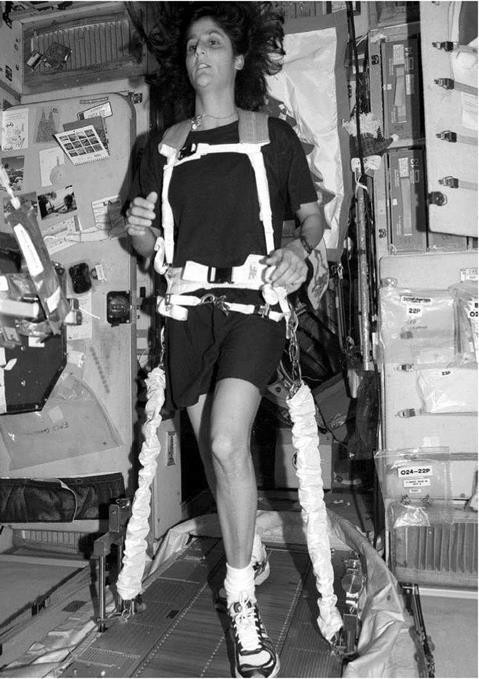PROGRESS M-59
Progress M-59 was launched from Baikonur at 21: 12, January 17, 2007, and was successfully placed into orbit. The spacecraft’s launch shroud carried a painted portrait of Sergei Korolev, the famous Soviet spaceflight pioneer, to mark the 100th anniversary of his birth. Following a standard rendezvous, the unmanned cargo vehicle docked to Pirs at 21 : 59, January 19. The arrival of 2,561 kg of new supplies was followed by a week of routine exercise, maintenance, and experiments. Lopez-Alegria, Tyurin, and Williams spent time unloading Progress M-59 and also began preparations for a Stage EVA. On January 25, controllers in Houston manoeuvred the SSRMS to the position from which it would support the first EVA, while the crew reviewed their equipment and procedures.
The 50th EVA from ISS, as opposed to from a Shuttle airlock, began at 11: 14, January 31, as Lopez-Alegria and Williams left Quest wearing American EMUs. After collecting their tools they made their way to the area between the Z-1 Truss on Unity and S-0 ITS on Destiny, at the centre of the ITS. They worked to de-mate and re-route two electrical connectors running between the Z1 Truss and S0 ITS, to Destiny. During the next EVA the electrical harness would be extended from Destiny to PMA-2. When complete, the Station-to-Shuttle Power Transfer System (SSPTS) would allow docked Shuttles to draw electrical power from the station, thereby extending their flights to 14 days in duration. The SSPTS was due to be used for the first time during the flight of STS-118, then planned for July 2007.
They also redirected four cooling lines, part of the temporary Early External Active Thermal Control System, which had been maintaining the station’s temperature since the P-6 ITS had been erected on the Z-1 Truss in 2000, and attached them to connectors for the permanent cooling system, the Low Temperature
|
Figure 84. Expedition-14: Sunita Williams runs on the treadmill in Zvezda. The elastic harness keeps her in place in the microgravity environment. |
Loop (Loop-А), which connected them to the heat exchangers in Destiny. The Low Temperature Loop carried heat away from the station’s environmental systems.
Having completed their work with the SSPTS the two astronauts joined together with controllers in Houston to continue their work on the station’s cooling system. Controllers commanded the starboard radiator, one of three, on the P-6 ITS to retract. Lopez-Alegria and Williams secured the retracted radiator in place. The second P-6 radiator would be retracted on the following EVA and the third later in the year, during the flight of STS-118. They covered the radiator to keep it at the correct temperature for the months between its retraction and re-deployment. The astronauts then turned their attention to disconnecting a fluid line to a reservoir, the Early Ammonia Servicer (EAS), on the P-6 ITS, securing it in a storage position. The Expedition-15 crew were to unbolt and jettison the EAS, but in the meantime, by securing the fluid line leading to it, the astronauts were preserving the ability to reinstate the system if needed. The two astronauts returned to Quest at 18: 09, after 7 hours 55 minutes.
After two days of rest and a third of preparations, Lopez-Alegria and Williams left Quest again, at 08:38, February 4, 2007. Once again, they made their way to the area between the Z-1 and S-0 ITS, where they had started their previous EVA. There they re-routed a further two electrical and four fluid lines. This time they reconfigured the Moderate Temperature Cooling Loop (Loop-В), which carried heat from the station’s avionics and payload racks. Next they joined with controllers in Houston to retract the P-6 aft radiator. The station’s orientation in relation to the Sun meant that the aft radiator did not require the installation of a thermal shield to maintain its temperature. With the radiator retracted, the astronauts disconnected and stowed the second EAS ammonia fluid line. Lopez-Alegria, positioned at the base of the P-6 ITS, photographed the starboard SAW and the blanket box into which it would be retracted during the flight of STS-117. With the photographs taken, both astronauts returned to re-routing the electrical system, from the S-0 ITS across the exterior of Destiny, and on to PMA-2, on the laboratory’s ram. The cables provided electrical power for the SSPTS. Three of the six cables were connected during this EVA. Lopez – Alegria also removed a sunshade from a data relay box on PMA-1, between Unity and Zarya. The EVA ended at 15: 49, after 7 hours 11 minutes, at which time Williams held the record for the total time spent in EVA by a woman.











